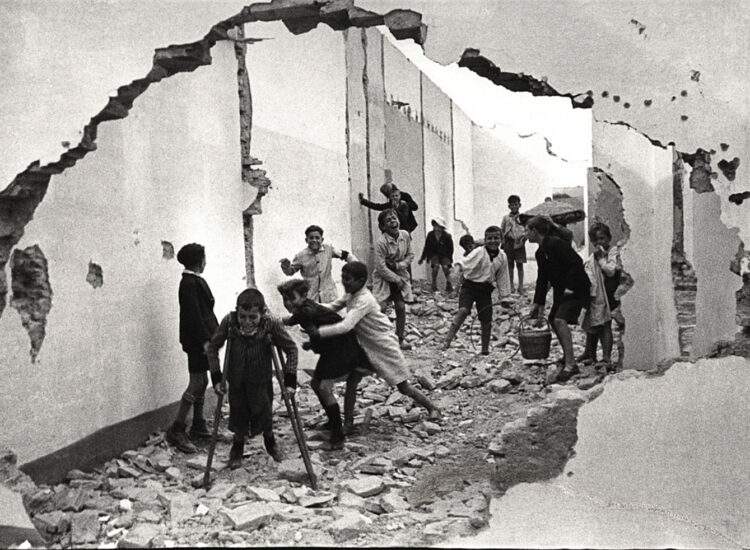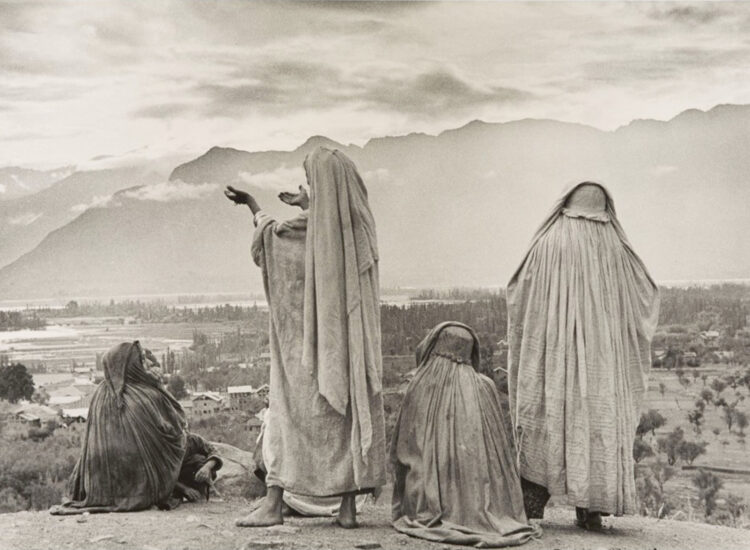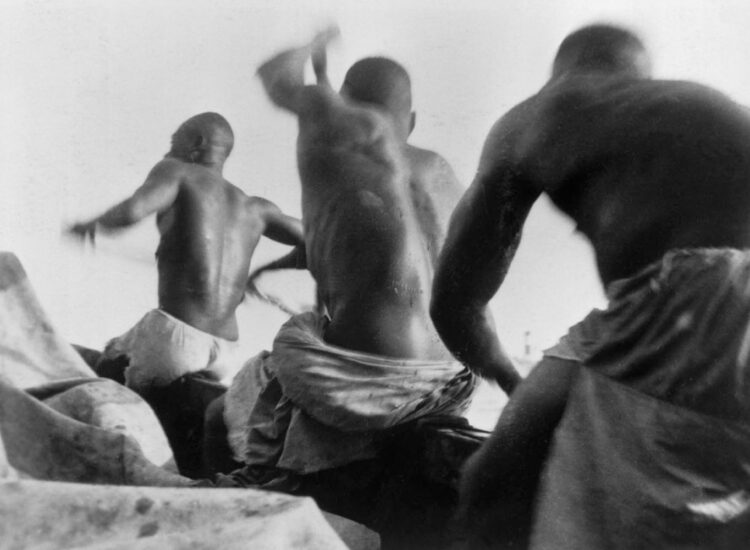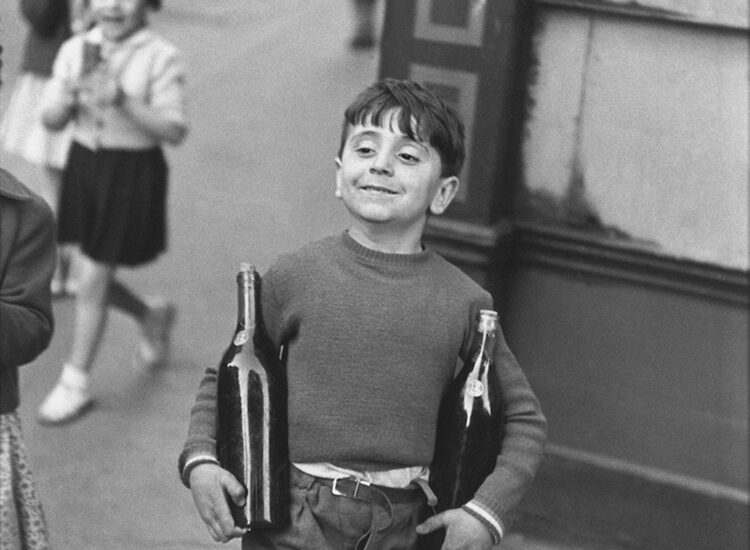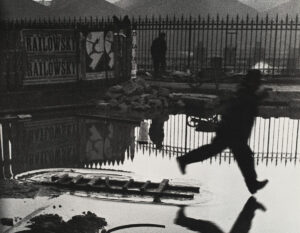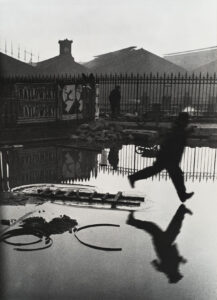By Amy Dienes
Photography is an art I’ve loved and worked at for years, and through my study of Aesthetic Realism that love has grown. Tonight I’m going to speak about one of the most famous photographs of the French photographer, Henri Cartier-Bresson, who is a photographer I care for very much. A reason is the way he showed that great meaning can be found in the ordinary things of reality. He had the ability to see and compose a scene in the viewfinder of his camera, and capture the “decisive moment”—a phrase which came to be synonymous with his work. Here are several of his well known photographs:
“Behind the Gare Saint-Lazare”
The photograph I am discussing is entitled, “Behind the Gare Saint-Lazare,” and was taken in 1932, at one of the large railroad stations in Paris.
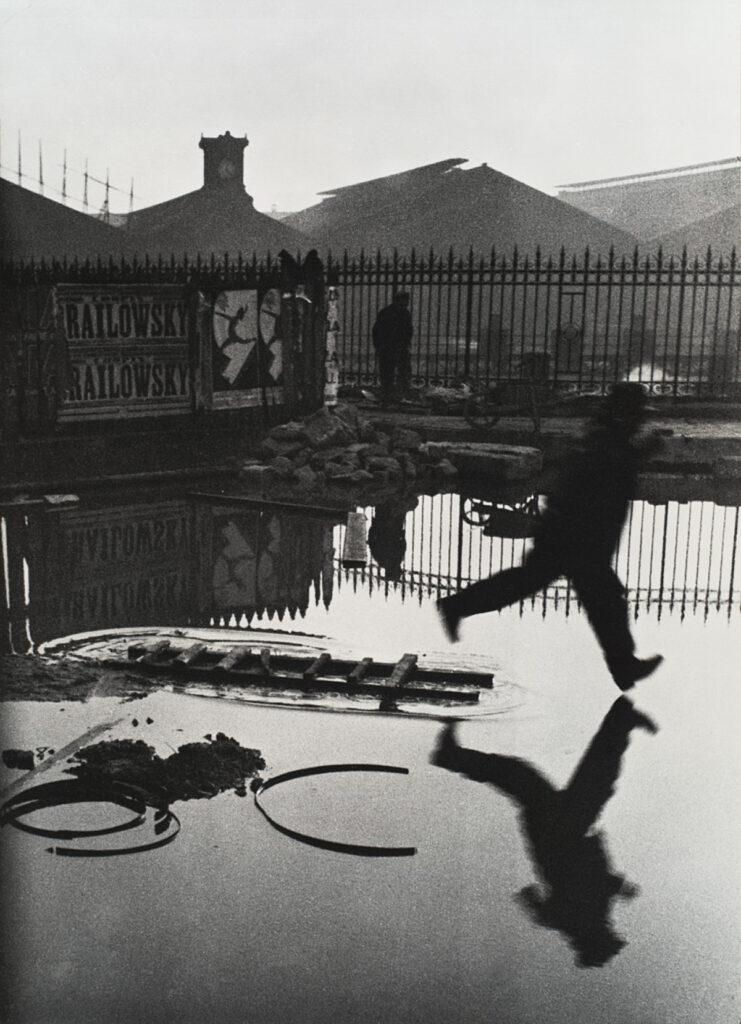
I’m going to speak about it in relation to the beginning opposites Aesthetic Realism shows every person is trying to put together: self and world—for it surely is about those very opposites. We see in the foreground the silhouette of one man in the midst of a leap. He is one particular individual in a bowler hat, taking a chance, and yet how richly and subtly Cartier-Bresson makes us see the relation of this man to the world around him.
As I’ve studied it, I’ve come to feel that it is one of the great photographs of the world because of the way it shows, through lines, shapes, forms and through light and dark, that the self is in an unlimited relation to reality, and it is that relation which gives the self meaning and grandeur.
The Self Is Individual and Related
In an Aesthetic Realism class in 1976, Eli Siegel spoke to me about something I was concerned about–the way I kept to myself and wanted to be separate from other people. He asked me:
Eli Siegel: Do you want to go for the self including and being in relation or the self being all by oneself? …Do you want to think there is a certain value by being apart from other things that cannot be replaced?
I did feel that, though I’d never put it to myself that way. Mr. Siegel continued:
What kind of self do you want to have? This is the subject of Aesthetic Realism….Every person is asking all the time: What kind of self do I want to have?
These questions were the beginning of a big change in me. And I was excited as I saw that Cartier-Bresson’s photograph comments on Mr. Siegel’s question: “Do you want to go for the self including and being in relation or the self being all by itself?”
The man in this photograph is clearly both! It is he alone who is making that leap. And yet, at the same time, look how much he’s in relation! First we see his image is repeated in the water upside down. There is such drama as the point of his heel almost, but not quite, touches the glassy, as yet, undisturbed, surface of the water. Then we see the V shape in his striding legs is repeated not only in his reflection, but in the rooftops in the background above. And then all at once we see on the far wall there are posters with two silhouetted figures leaping, as the man is, but in the opposite direction. That is perhaps the most amazing relation in the photograph, and it was captured not only by chance.
Cartier-Bresson is quoted in the book, Dialogue with Photography, as saying:
To take photographs means to recognize—simultaneously and within a fraction of a second—both the fact itself and the rigorous organization of visually perceived forms that give it meaning. It is putting one’s head, one’s eye and one’s heart on the same axis.
Implied here is something Aesthetic Realism taught me, that it is the relation among things—what Cartier-Bresson calls “the rigorous organization of….forms”—that gives a fact meaning. This, I’ve seen is just as true when the fact is a fact about our very own selves.
For example, in my position as a nurse, though I worked closely with people, I did not see myself as like them. Even though I often took photographs of persons in the hospital, I didn’t see taking care of people as related to my photography. The time I thought I was most myself was when I was by myself. I liked my work, but when I went home, very often with take out food, I’d sit down in front of the TV and feel “now is the time for me!” The rest of the world would become dull and unimportant. Meanwhile, I often felt lonely and empty, and increasingly, that things didn’t mean too much to me and I worried about going through life feeling that. Aesthetic Realism changed this—to my everlasting gratitude. I learned that like every person I was trying to put opposites together, and two of these opposites are what I’ll speak of next.
We Are Horizontal and Vertical
In his book Self and World, Mr. Siegel has these beautiful and scientific sentences about directions in the self:
The vertical line is a symbol to the unconscious of the self alone; the horizontal, of the self going out….The down and up motion of a line is like the ego given to nothing but itself. The horizontal line represents the ego going out as an offset to verticality.
In this photograph there is an interplay of horizontals and verticals making for solid structure within disorder and mistiness.
The format of Cartier-Bresson’s photograph is vertical but is divided into horizontal bands of alternating light and dark. The poles of the fence are regularly vertical but, as you look at the fence, it becomes horizontal as it travels across the photograph. There are other horizontal lines, the debris, the ladder, the reflection of the fence, the Brailowsky billboards. The way horizontal and vertical join most dramatically is in the leaping figure who is a vertical gracefully changing into a horizontal in his leap. How kind of Cartier-Bresson to show with such grace and style that “the self alone,” “the ego given to nothing but itself”; and “the self going out” can be seen as one and the same of a Paris afternoon. I am sure that this is what made me love this photograph at first sight.
Because the man is a black shape without detail, he is also abstract. He seems to represent humanity. You get the feeling of a conservative businessman, in suit and bowler hat, and here he is, leaping into the unknown. He is like all of us, conservative and bold, ordinary and mysterious. There is another man at the fence who is also a dark shape. He looks more hidden, and he is indeed, just a vertical without the diagonals of the moving figure. He seems to represent the other side of self—“the self alone,” rather than the “the self going out,” yet as he stands there between the leaping man and the leaping dancer in the posters, connected to them by the horizontal fence, we feel the two aspects of self once again completing each other.
In his great lecture, Aesthetic Realism as Beauty: Photography, Mr. Siegel said:
Photography itself we should know, and the great work in it, because it helps us to know what we want.
Yes, and this work of Cartier-Bresson has enabled me to see more clearly what I want, and what kind of self I want to be.
There is a great deal more that could be said about the beauty of this photograph. Cartier-Bresson presents here a world we can honestly like, and the man in his leap, in his energy, in his abandon to the splash that is to come–this man represents the spontaneous letting-go that we all want to have, the going out to the world with welcoming generosity. This photograph shows resoundingly, joyfully, that the self is more itself through relation.
This talk was published in The Journal of the Print World and The Philipine Post. First given in the Terrain Gallery series “Art Answers the Questions of Your Life.”

